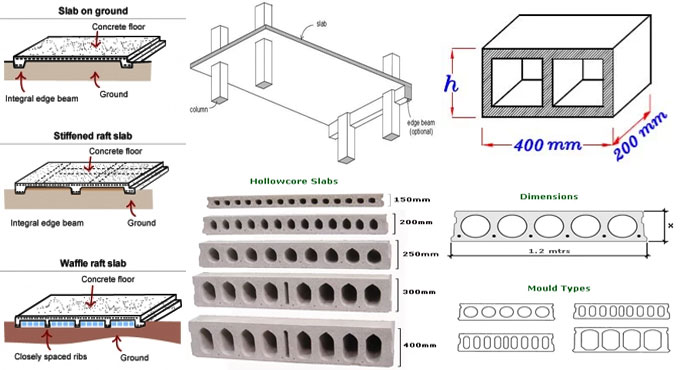
Concrete slab construction methods & types
A reinforced concrete slab is a vital structural element. The purpose of flat slab is to arrange flat surfaces(floors and ceilings) in buildings. Slabs are usually categorized into one-way slab and two-way slab based on the reinforcement placed, beam support, and the proportions of the lengths. The support for one slab is provided on two sides and the proportion of long to short span is more than two. On the other hand, the support for two way slab is given on four sides and the proportion of long to short span is less than two.
Depending on the type of building, architectural layout, aesthetic features, and the span length, the perfect and reasonable concrete slab is selected. So, the types of concrete slabs are one-way joist slab, flat slab, flat plate, waffle slab, hollow core slab, precast slab, slabs on grade, hardy slab, and composite slab. Given below, the details about concrete slab construction methods and the types of concrete slabs.
1. One-Way Slabs on Beams: With cast in situ method, the one-way slabs on beams is built up. The construction process comprises of securing of forms followed with the set up of reinforcements, and lastly the pouring of fresh concrete.
One-way slabs on beams contain the lengths of 3-6m, and a live load of 3 to 5KN/m2. They are also useful for bigger lengths with considerably greater cost and slab deflection. Extra formwork for the beams is however required.
2. One-way joist slab (Ribbed slab): It comprises of a floor slab with thickness 50 to 100mm, supported with reinforced concrete ribs (or joists). The ribs are normally tapered and are consistently placed at distances that do not go beyond 750mm. The ribs are supported on girders that build on the columns.
A one-way joist concrete slab contains lengths of 6-9m and live loads of 4-6KN/m2. Due to the deep ribs, the concrete and steel quantities are considerably low, but costly formwork is required.
3. Waffle Slab (Grid slab): This type of reinforced concrete slab comprises of square grids containing deep sides. Waffle slab construction method involves fixing forms, arrangement of pods on shuttering, set up of reinforcement among pods, set up of steel mesh on top of pods, and pouring of concrete.
Grid slabs contain lengths of 9-15m and live loads of 4-7KN/m2. Formwork along with the pans, is quite costly.
4. Flat Plates: Flat plates are erected as one-way or two-way slabs and support is provided directly through columns or walls. The construction process is easy and simple formworks are required.
Flat plates contain length of 6 to 8m, and live loads among 3 and 5KN/m2. Besides, the extent of spans for pre-stressed flat plates remains among 8-12m, and it can also be erected as post-tensioned slabs.
The flat plates provide various benefits like low-cost formwork, uncovered flat ceilings, and rapid construction. Flat plates contain low shear strength and considerably low stiffness, which may lead to significant deflection.
5. Flat Slabs: It normally stands for a reinforced slab that is supported directly with columns or caps, devoid of the beams. The construction process for this type of slab is simple and needs less formwork. The loads are transmitted to the columns directly.
Flat slabs are perfect for the spans of 6 to 9m, and for live loads of 4-7KN/m2. They require extra formwork as compared to flat plates, particularly for column capitals. In several situations, only drop panels exclusive of column capitals are applied. It is erected as post-tensioned flat slabs.
To get more details about other types of slabs, go through the following link theconstructor.org


